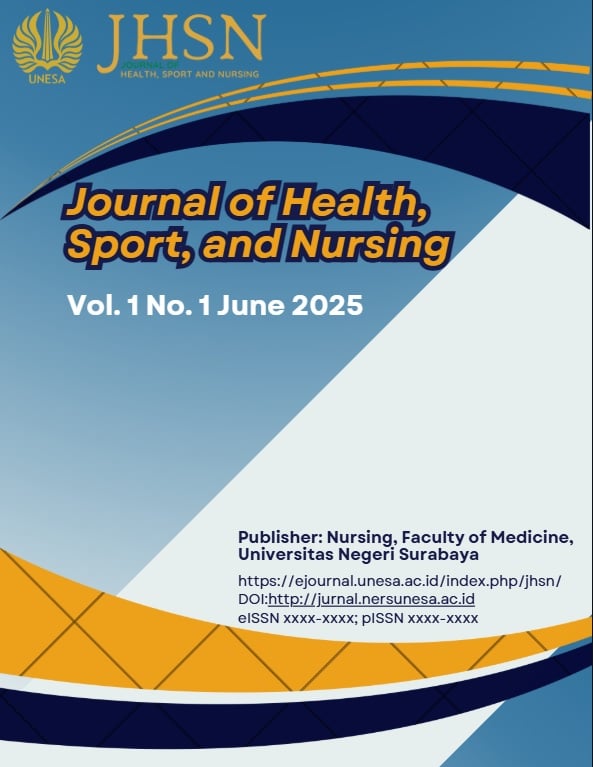The level of independence and the level of life satisfaction among the elderly: a Cross-sectional study in Nursing Home
Abstract
Elderly people will experience physical, psychosocial, and cognitive changes due to aging. These changes make the elderly at high risk of losing functional abilities, reducing their independence in daily activities and becoming dependent on others. The decline in the ability of the elderly to perform daily activities affects their quality of life and life satisfaction. This study aimed to analyze the correlation between the level of independence and the level of life satisfaction among the elderly at nursing home of Jember. This study used a cross-sectional design with total sampling on 73 respondents. The Katz Index was used to identify the level of independence, and the Satisfaction with Life Scale (SWLS) was used to identify the level of life satisfaction among the elderly. Data were analyzed using the Kendal Tau-C test. The results showed that the majority of the elderly were independent (83.6%) and had a slightly satisfied life satisfaction (37.0%). Based on the results of this study, there was a correlation between the level of independence and the level of life satisfaction among the elderly at nursing home of Jember (p-value=0.024; r=0.750). It can be concluded that the higher the level of independence, the higher the life satisfaction of the elderly. Therefore, the elderly must maintain their health and physical activity regularly to prevent significant physical decline. The role of nurses/caregivers is to provide assistance to the elderly according to their abilities and pay attention to their social and spiritual needs.
Downloads
References
Alligood MR. (2014). Nursing Theory Utilization & Application. Vol. 11, International Journal of Aeroacoustics. 177–196 p.
BPS. (2022). Statistik Penduduk Lanjut Usi a. 2022. 348 p.
BPS. (2021). Jumlah Penduduk Menurut Kelompok Umur di Kabupaten Jember [Internet]. 2020. Available from: https://jemberkab.bps.go.id/statictable/2021/11/08/318/jumlah-penduduk-menurut-kelompok-umur-di-kabupaten-jember-2020.html
de Oliveira Almeida K, Nogueira Alves IG, de Queiroz RS, de Castro MR, Gomes VA, Santos Fontoura FC, et al. (2023). A systematic review on physical function, activities of daily living and health-related quality of life in COVID-19 survivors. Chronic Illn, 19(2):279–303.
Diener, E., & Biswas-Diener R. (2008). The science of optimal happiness. 290 p.
Eckstrom E, Neukam S, Kalin L, Wright J. (2020). Physical Activity and Healthy Aging. Clin Geriatr Med [Internet] 36(4):671–83. Available from: https://doi.org/10.1016/j.cger.2020.06.009
González-Herero V, García-Martín MÁ. (2012). Personality, Activities, and Well-Being: A Study Based on Women in Late Adulthood. J Women Aging. 24(2):152–68.
Karina S. (2021). Peran Rasa Syukur Dan Dukungan Sosial Terhadap Kesepian Pada Lanjut Usia Di Panti Wreda. Psikol Konseling. 19(2):1151.
Kardas F, Cam Z, Eskisu M, Gelibolu S. (2019). Gratitude, hope, optimism and life satisfaction as predictors of psychological well-being*. Eurasian J Educ Res.(82):81–100.
Kurdi F, Susumaningrum LA, Rasni H, Susanto T. (2022). Implementasi Pencegahan Komplikasi Hipertensi Melalui Therapeutic Nape Massage Pada Lansia. Disem J Pengabdi Kpd Masy. 4(1):43–7.
Listiyandini RA, Nathania A, Syahniar D, Sonia L, Nadya R. (2017). Mengukur Rasa Syukur: Pengembangan Model Awal Skala Bersyukur Versi Indonesia. J Psikol Ulayat. 2(2):473.
Mauk KL. (2016). Gerontological Nursing COMP ETENCIES FOR CARE. Vol. 4. 1–865 p.
Meiner SE. Gerontologic Nursing. Vol. 29, Journal of Neuroscience Nursing. 2015. 57–58 p.
Orem DE, Denyes MJ, Bekel G. (2001). Self-Care: A Foundational Science. Nurs Sci Q. 14(1):48–54.
Pavot W, Diener E. (1993). Review of the satisfaction with life scale psychological assessment. Psychol Assess [Internet]. 5(2):164–72. Available from: http://link.springer.com/10.1007/978-90-481-2354-4
Potter PA, Perry AG. (2010). Fundamental of Nursing. Singapore: Selemba Medika. iii–674.
Putri D, Hamidah. (2014). Hubungan antara Kemandirian dalam Melakukan Aktivitas Sehari-hari dengan Kepuasan Hidup pada Lanjut Usia yang Mengalami Stroke. J Psikol Ind dan Organ. 3(3):137–42.
Ratnawati E. (2018). Asuhan Keperawatan Gerontik. Yogyakarta: Pustaka Baru Press; 1–208 p.
Sari, W., P. Dewi., & A. Susanto. (2022). Gambaran Tingkat Kemandirian Lansia dalam Pemenuhan ADL (Activity Daily Living). 1(12):3403–10.
Touhy TA, Jett KF. (2016). Toward Healthy Aging: Human Needs and Nursing Response [Internet]. Available from: https://books.google.co.th/books?id=FIKtxgEACAAJ%0Ahttps://www.amazon.com/Toward-Healthy-Aging-Book-Response-ebook/dp/B0B6JKF6WP/ref=tmm_kin_swatch_0?_encoding=UTF8&qid=&sr=
United Nations. (2022). World Population Prospects 2022. World Population Prospects. 2022.
Downloads
Published
How to Cite
Issue
Section
License
Copyright (c) 2025 Fahruddin Kurdi, Anggraini Probowati, Niken Asih Laras Ati

This work is licensed under a Creative Commons Attribution-NonCommercial 4.0 International License.
In line with the license, authors and any users (readers and other researchers) are allowed to share and adapt the material only for non-commercial purposes. In addition, the material must be given appropriate credit, provided with a link to the license, and indicated if changes were made. If authors remix, transform or build upon the material, authors must distribute their contributions under the same license as the original.
 Abstract views: 76
,
Abstract views: 76
, PDF Downloads: 60
PDF Downloads: 60





